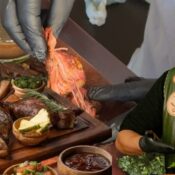
The Best Tunisian Street Food: Must-Try Dishes When Visiting Tunisia
Tunisia boasts a unique and diverse cuisine, rich in delicious dishes and wonderful flavors that leave a lasting impression on everyone who tastes them. And you, dear readers—if you decide to visit our country, be sure to add the foods we mention below to your list, as they are sure to impress you.
• Sahlab:
You can start your day with a bowl of Sahlab, one of the most popular sweet dishes found in Tunisian shops and cafés. It is usually eaten for breakfast and is also made in Ramadan for fatour and for suhoor, and in winter to fight off the cold.
• Lablabi:
This traditional dish is often requested by foreigners and tourists visiting Tunisia. Though it has simple Turkish-inspired flavors, it’s a distinctive dish—especially in the winter. Made from a mix of chickpeas, stale bread, and other everyday ingredients like olive oil, eggs, harissa, pickled vegetables, spices, and capers, it offers a unique taste and provides energy. You can also add beef to the dish, a version known as Hargma.
• Tunisian Sandwich (Kaskrout):
A dishe that everyone loves and is often willing to queue for. This sandwich combines Tunisian salad, harissa, boiled eggs, a bit of tuna, pepper, olive oil, lemon, and green olives.
• Tastira and Kafteji:
This dish is just as important as other traditional meals and is eaten daily by Tunisians. It is made from fried vegetables like peppers, tomatoes, potatoes, and zucchini, which are then mixed to make Tastira. A fried egg and potatoes are added, along with ground chili pepper, green olives, and a pinch of thyme.
• Fricassé:
A popular, light, and delicious dish. It consists of fried dough pastries stuffed with Tunisian harissa, tuna, boiled potatoes, and boiled eggs. Fricassé is especially loved and is usually considered a snack in the evening as it helps relieve the fatigue of a long day of work
• Brik:
The crown of the Ramadan table in Tunisia. Its fame comes from being served as an appetiizer during Ramadan, making it very popular and in high demand. It’s a delicious and easy-to-make food. Brik is made from very thin pastry filled called “malsouka” with a mixture of parsley, egg, potato, cheese or tuna—or any filling you like. The filling is sealed, then either deep-fried or baked until done.
Restaurants also serve briks as a snack with a squeeze of lemon. Some people even eat it in the morning.
• Hargma :
A heavy Tunisian dish due to its rich nutritional content, it requires expertise and great attention to cleanliness in preparation. For decades, certain restaurants have specialized in serving Hargma. It is usually added to the Lablabi dish, where head and foot meat are chopped into small pieces and mixed in, along with olive oil and garlic.
• Couscous:
One of Tunisia’s most beloved dishes, Couscous is typically prepared for special occasions and family gatherings. It’s known for its spicy flavor thanks to the use of harissa. It has a unique taste, especially when served with lamb. There are many ways to prepare it—with vegetables, milk, or by adding sugar and butter. The method of preparation varies according to personal tastes and the occasion.


